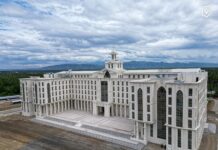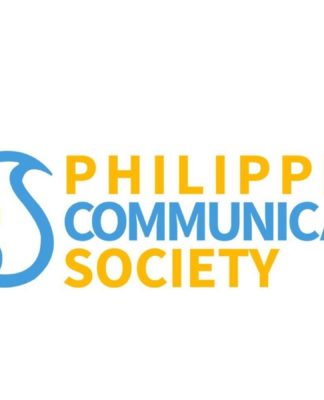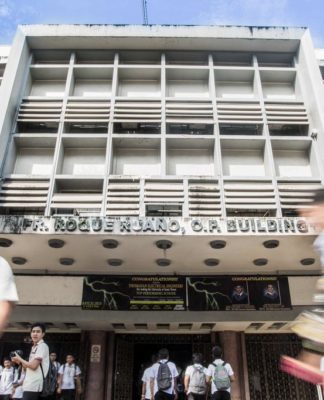SCHOLARS, writers and religious men from 23 countries discussed “Healing, Belief Systems, Cultures and Religions of South and Southeast Asia” in a conference at the Thomas Aquinas Research Complex (TARC) Auditorium last May 16-19.
The international conference was organized by the South and Southeast Asian Association for the Study of Culture and Religion (SSEASR), an affiliate of the International Association of the History of Religions (IAHR).
Sen. Edgardo Angara, chairman of the Senate Committee on Education, Arts and Culture, gave the keynote address, which emphasized the “cultural and religious dynamism” of the region.
Angara said dynamism would be a tool towards a new “Asian Century,” particularly the period 2025 to 2050, during which Asia would expand its economic influence.
“We are becoming the center of innovation, the center of research in the world and it is said that by 2025, our Asian output will be greater than European Union. By 2050, more than half of the world output will be produced by South Asia and Southeast Asia. Asia will be the biggest market in the world. Asia will no longer be just an exporter of cheap resources to the West,” Angara said.
“The diversity across South and Southeast is endless, it is a home of various ethnicities, cultures, and religions. Each country maintains its uniqueness,” Angara added. “Such cultural diversities are complimented by economic dynamism. By virtue of South and Southeast Asian proximity, linkages are not only ideal, they are essential.”
Rector Fr. Herminio Dagohoy, O.P. and SSEASR President Dr. Amarjiva Lochan gave the welcome remarks.
Other speakers were IAHR President Prof. Rosalind Hackett, who discussed “Healing through Sound and Music: From Ancient Theologies to (Pseudo)science”; Prof. Lilian Sison, dean of UST Graduate School, who talked about “Religion and the Peace Project in Mindanao”; and Prof. Cristina Pantoja-Hidalgo, director of UST Center for Creative Writing and Studies, who discussed “Women and Culture in Philippine Literature.”
The SSEAR conference is held every two years. The previous conferences were held in New Delhi, India (2005); Bangkok, Thailand (2007); Bali, Indonesia (2009); and Thimphu, Bhutan (2011).
Marian devotions in the Philippines
Meanwhile, Gerardo Guiuan, senior research associate of St. Paul University in Manila, discussed “Healing Dimensions in Four Filipino Marian Devotions in the Philippines.” Guiuan said the faithful’s relationship with Christ was connected to the Catholic devotion to Mary, as stated in the Catechism for Filipino Catholics (CFC).
“Devotion to Mary has always been intimately intertwined with Christ. Marian devotion and piety seem co-natural to us Filipinos,” he said.
There are three kinds of Marian devotions and one Marian liturgical practice in the Philippines: devotion to Our Lady of Salambao, healer of couples seeking the happiness of fruitfulness; devotion to Our Lady of Caysasay, whom Filipino Catholics consider as “helper in life’s sufferings”; devotion to Our Lady of the Bible, a “guide committed to the cause of goodness in the world”; and Salubong, done for “healing as a woman of resilient faith.”
Through Our Lady of Salambao, the grace of God in childbirth is seen, he said.
It is a challenge for married couples to nurture Christian love, but childlessness is also a gift “for them to be courageous in facing life,” he said.
Our Lady of Caysasay is an image said to have been found in the water by Rev. Fr. Antonio Serra in 1611. Guiuan said Our Lady of Caysasay signified “cleansing and rebirth manifested in the celebration of Baptism.”
“She reminds her simple devotees to go beyond physical suffering or sickness in life and uncover an essential meaning to its reality,” he said. “The devotion will be inspired not by so-called superstitious motivations, but by a deep realization of Jesus’ sufferings as shared by Mary, and a personal relationship with Him who transforms human sufferings to the level of spiritual redemption.”
The devotion to Our Lady of the Bible encourages the faithful to deepen their relationship with Christ, through the study of His word.
“[Our Lady of Bible] symbolizes that Mary, in heaven, invites each one to read the Bible and be at the service of the Word, for such happened in her conception of God’s Word in her heart and womb,” Guiuan said.
Guiuan described the Salubong as “affective and emotionally focused, for it comes from the heart and is intensely human.” He said the Salubong signified the healing of Mary’s suffering after seeing her risen son.
The Salubong also symbolizes the strength of the Filipinos amid the weight of life’s suffering and setbacks, Guiuan said.
Women and religion
Meanwhile, Religion Studies Prof. Morny Joy of the University of Calgary in Canada discussed “Women Rights and Religion in South and South East Asia.”
Joy said the problems experienced by women were caused by the opposition of religious fundamentalists and secularists to the progress of women's rights.
“In addition, post-colonial scholars are very critical of human rights. The basic problem in all these issues is that religion and rights are mutually exclusive in a very strict binary of division. Women with religious backgrounds need to cooperate through dialogues wherein religion and human rights can be combined,” Joy said.
Joy called on religious fundamentalists to stop using tradition and culture to hinder the progress women's rights. But multiculturalism, “which respects the rights of every women of different religions,” must be accepted instead of a secular point of view, which, she said, had yielded no progress in people’s rights.
Another speaker on women and religion, Jeane Peracullo, assistant professor at the Department of Philosophy of De La Salle University, discussed “Kumakalam na Sikmura: Hunger as Postcolonial Field of Faith.”
She cited the violence that hunger could cause to women around the world, but noted that it was through hunger that women were made conscious of their physical needs.
“Kumakalam na Sikmura explicitly draws attention to the relationship between the body, its owner, and the social and cultural world it is part of,” she said.
While hunger gives pain, it is also through the hunger experienced physically, mentally, and spiritually that a person is made conscious of the need to improve and change mistakes in society, Peracullo said.
Hunger can also be seen in a positive light when it is done as a form of protest against wrongdoings.
“Hunger strike is a common feature in the lives of the Filipinos, both non-indigenous and indigenous. It is unthinkable to resort to hunger as a form of protest. However, people do so in numerous situations, which reveals the gentle nature of hunger,” Peracullo said. GERVIE KAY S. ESTELLA and GRACELYN A. SIMON




















